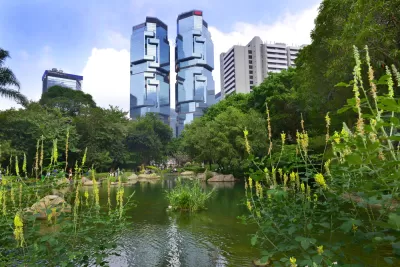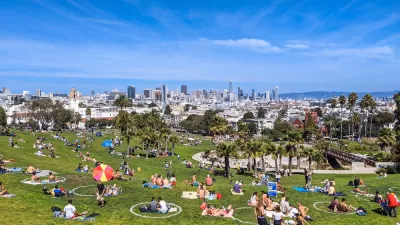Hong Kong provides a lesson in the importance of open space for the health and well-being of residents, especially during the isolation and distancing of a pandemic.

Parks are known to offer a variety of physical and mental health benefits. They are much needed, especially in dense places like Hong Kong where many people live in tight quarters in high-rise buildings. While public green spaces account for 40% of the total land in Hong Kong, it takes an average of one hour for residents to reach one of the largest parks which are known in the city as country parks.
In this article, Chermaine Lee explains the open space challenges that impact the health and well-being of the 7.5 million people living in Hong Kong:
- Hong Kongers have just 29 square feet of accessible public space per person, which is slightly larger than a coffin or a toilet cubicle. In comparison, according to a 2017 study from Civic Exchange, Singapore offers 79.6 square feet of public space per capita and New York City, also known for its high land price, has more than 107.6 square feet of public space per capita.
- Hong Kong's parks are not particularly user-friendly. Grassy or landscaped areas are typically off limits so that park patrons are only able to look at, but not rest or relax on them. As Hendrik Tieben, director of the urban design program at the Chinese University of Hong Kong, explains, "There’s not much you can do in the [urban] parks, like sitting on the grass, eating in a park and so on... People are not allowed to touch the plants most of the time."
- Staying at home is not a great option for the many Hong Kongers who live in very limited space due to extremely high housing costs.
- Historically, creating accessible public open spaces has not been a priority for the government and privately-owned public spaces are not always welcoming or truly accessible to all.
The article goes on to describe efforts to transform more of Hong Kong's underused areas into public spaces to meet the needs of its residents. The Hong Kong government has made some progress over the years, including building waterfront promenades. The Leisure and Cultural Services Department, which is responsible for managing the city’s parks, has increased the number of pet gardens from 19 in 2010 to 45 in 2019. The department also provides 50 multi-purpose lawns for public use, rising from 39 in 2010 to 51 in 2018.
FULL STORY: Hong Kong’s public space problem

Planetizen Federal Action Tracker
A weekly monitor of how Trump’s orders and actions are impacting planners and planning in America.

Map: Where Senate Republicans Want to Sell Your Public Lands
For public land advocates, the Senate Republicans’ proposal to sell millions of acres of public land in the West is “the biggest fight of their careers.”

Restaurant Patios Were a Pandemic Win — Why Were They so Hard to Keep?
Social distancing requirements and changes in travel patterns prompted cities to pilot new uses for street and sidewalk space. Then it got complicated.

Platform Pilsner: Vancouver Transit Agency Releases... a Beer?
TransLink will receive a portion of every sale of the four-pack.

Toronto Weighs Cheaper Transit, Parking Hikes for Major Events
Special event rates would take effect during large festivals, sports games and concerts to ‘discourage driving, manage congestion and free up space for transit.”

Berlin to Consider Car-Free Zone Larger Than Manhattan
The area bound by the 22-mile Ringbahn would still allow 12 uses of a private automobile per year per person, and several other exemptions.
Urban Design for Planners 1: Software Tools
This six-course series explores essential urban design concepts using open source software and equips planners with the tools they need to participate fully in the urban design process.
Planning for Universal Design
Learn the tools for implementing Universal Design in planning regulations.
Heyer Gruel & Associates PA
JM Goldson LLC
Custer County Colorado
City of Camden Redevelopment Agency
City of Astoria
Transportation Research & Education Center (TREC) at Portland State University
Camden Redevelopment Agency
City of Claremont
Municipality of Princeton (NJ)





























